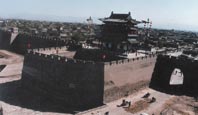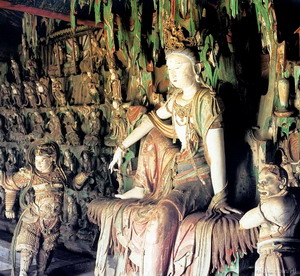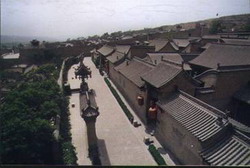Pingyao City Wall

Pingyao was built in the West Zhou Dynasty (827-728 B.C) when General Yin Jipu stationed his troops here to prevent an invasion of barbarians. The original city walls of Pingyao were of tamped earth and were located northwest of the present city.Pingyao city, originally named Pingtao, was built in the early Northern Wei Dynasty. In 424, its name was changed to Pingyao.
Over the centuries its walls were rebuilt and lengthened from 9 li plus eighteen paces to over 12 li, (6.4 kilometers). The outside was faced with stones and bricks starting in 1370, and the wall underwent frequent repairs and rebuilding during the Ming and Qing Dynasties. It's ten meters high, 6163 meters around, and three to five meters wide at the top. While the west, north and east walls are straight, the southern one curves, forming a rough square. The northern and southern walls have one gate each, the eastern and western walls, two each. Each gate has a barbican entrance with an inner and an outer door and had a tower above it, three of which have been rebuilt. Each gate used to have a drawbridge to cross the moat, which today is outside three sides of the city and is more than 3.3 meters deep and 3.3 meters wide. Scholar trees and willows formerly lined the moat.
The tortoise is a symbol of eternity. Seventy-two watch towers were built every fifty to one hundred meters along the top. Two-meter high walls were built along the outside of the wall's top, with 3,000 crenelations with openings for shooting. These represent the 72 disciples and more than 3,000 students of Confucius. Seventy-seven brick lined drains remove water from the walls. Each corner formerly had a grand tower, but only the Great Scholar Tower in the southeast remains, along with one roll-call platform. A temple used to occupy the large platform on the eastern wall.




